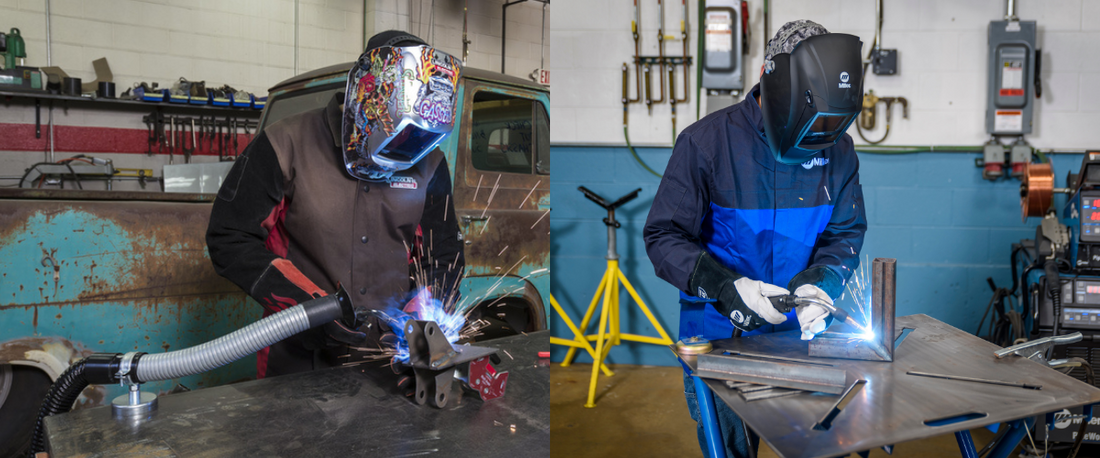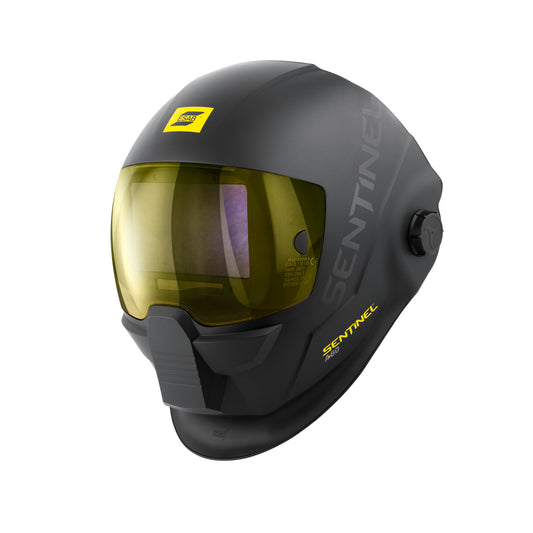We all know that Lincoln’s Viking 3350 and Miller’s Digital Elite are two of the top welding helmets on the market. However, whenever you read a discussion on a welding forum about which one is better, it’s hard to find everything you need to know about both helmets in one place. There’s usually someone who shares about his experience with one helmet, but it’s rare to find someone who has owned both helmets and can offer a simple side by side comparison. The post that follows will dig into what both helmets share in common and what makes them different so you can compare them both in one place.
While a welding helmet comparison requires digging into the fine details of each helmet, it’s important to remember that both helmets are top of the line products. There is no shortage of stories about welders who have bought one of these helmets who will never buy a different helmet again. So while we can pick apart some flaws in each product, it’s going to become quite clear that both helmets offer many of the same features.
The real differences come down to user preferences, comfort, and a few other factors. We’ll begin by looking at what both helmets share.
What Lincoln and Miller’s Welding Helmets Share
Both helmets offer four sensors and a wide selection of lens shades that will protect your eyes while still providing excellent visibility. You’ll be able to easily TIG weld, MIG weld, or stick weld with either helmet.
Both helmets also have a grinding mode that makes it possible to use your helmet in a variety of metal prepping applications. Without grinding mode, your auto-darkening helmet won’t work for a grinding project.
The combination of batteries and solar power on both helmets is another plus for users who need the reliability of a battery and the economy offered by solar power.
Generally speaking, users of both helmets say they are comfortable and can be adapted to hard hats. Reviewers of the Digital Elite have especially praised the cranking mechanism that allows you to keep your helmet up without it sliding down.
If you need to use a magnifying lens, both helmets offer that feature.
Advantage Lincoln
One of the most common reasons welders choose the Viking helmet over the Digital Elite is the price. Depending on the deals you find, the Viking could cost anywhere from $50 to $100 less. However, prices and promotions fluctuate online so regularly that the price difference one day may be negligible (as of this writing, the price difference between the two helmets at Baker’s Gas and Welding is within $34). Nevertheless, the Viking helmet tends to cost less on a regular basis.
Lincoln’s 3350 Viking helmet also enjoys a few edges on Miller. For example, the Viking viewing area is slightly wider, 3.74 in x 3.34 in to Miller’s 3.85 in x 2.38 in. In addition, the replacement lens for the Viking helmet is a standard size on the Viking helmet. If you need a new lens on the weekend when the welding supply store is closed, the Digital Elite uses a lens that is custom-built by Miller and isn’t available in hardware stores. That may be a significant draw back for the hobby welder who needs to replace a lens while working on a Sunday afternoon welding project. Lincoln’s lens versatility may not matter quite as much to welders who work during the week at a shop.
Though the lens speeds are nearly identical for both helmets, the Viking helmet’s lens speed is 1/25,000 compared to Miller’s 1/20,000.
While some welders will certainly use the Digital Elite for overhead welding projects, it’s not technically rated for overhead welding in the specs. If you plan on doing a lot of overhead welding, consider the Viking helmet.
Advantage Miller
The most talked about feature in the Digital Elite is X Mode, a setting that you can turn on in order to reduce the possibility of being flashed in tight spaces or while working on pipe lines. This feature may be the single greatest deciding factor for some welders who work out of position and need the extra protection of X Mode.
X Mode detects the electromagnetic field from the welding arc and provides continual eye protection even if the sensors can’t pick up any flash from the welder. Most welders leave this setting on all of the time, since it removes any possibility of ever being flashed.
Which Auto-Darkening Welding Helmet Is For You?
For starters, you can’t go wrong with either auto-darkening welding helmet. Both helmets will protect your eyes and offer all of the best features you can ask for in a welding helmet. For some users the price and lens versatility of the Lincoln helmet will put it on top. For others the X Mode of the Digital Elite make it the perfect helmet. As with any other welding product, you’ll need to figure out which features work best for your welding needs.
Find the best deals for the Viking 3350 and the Digital Elite at Baker’s Gas and Welding.



